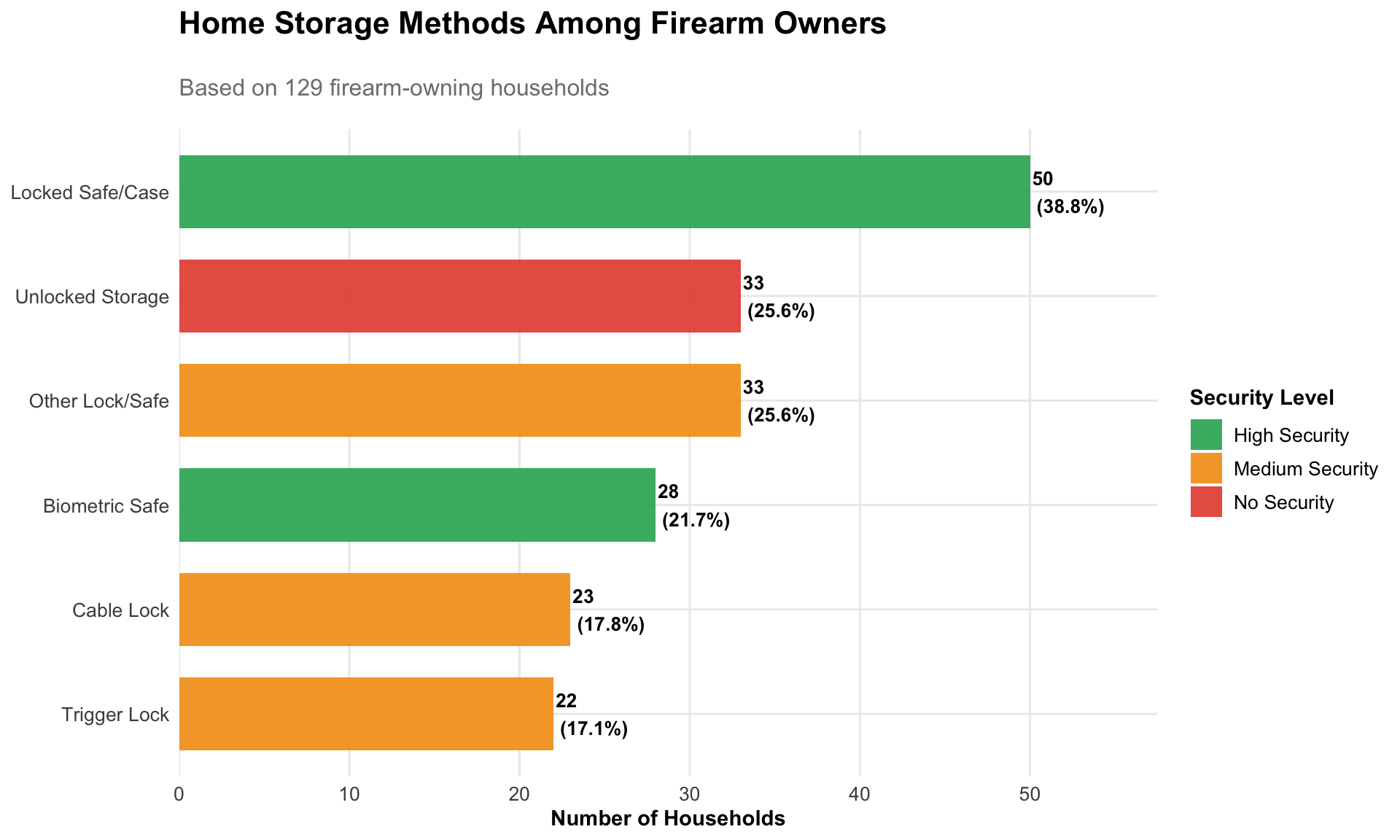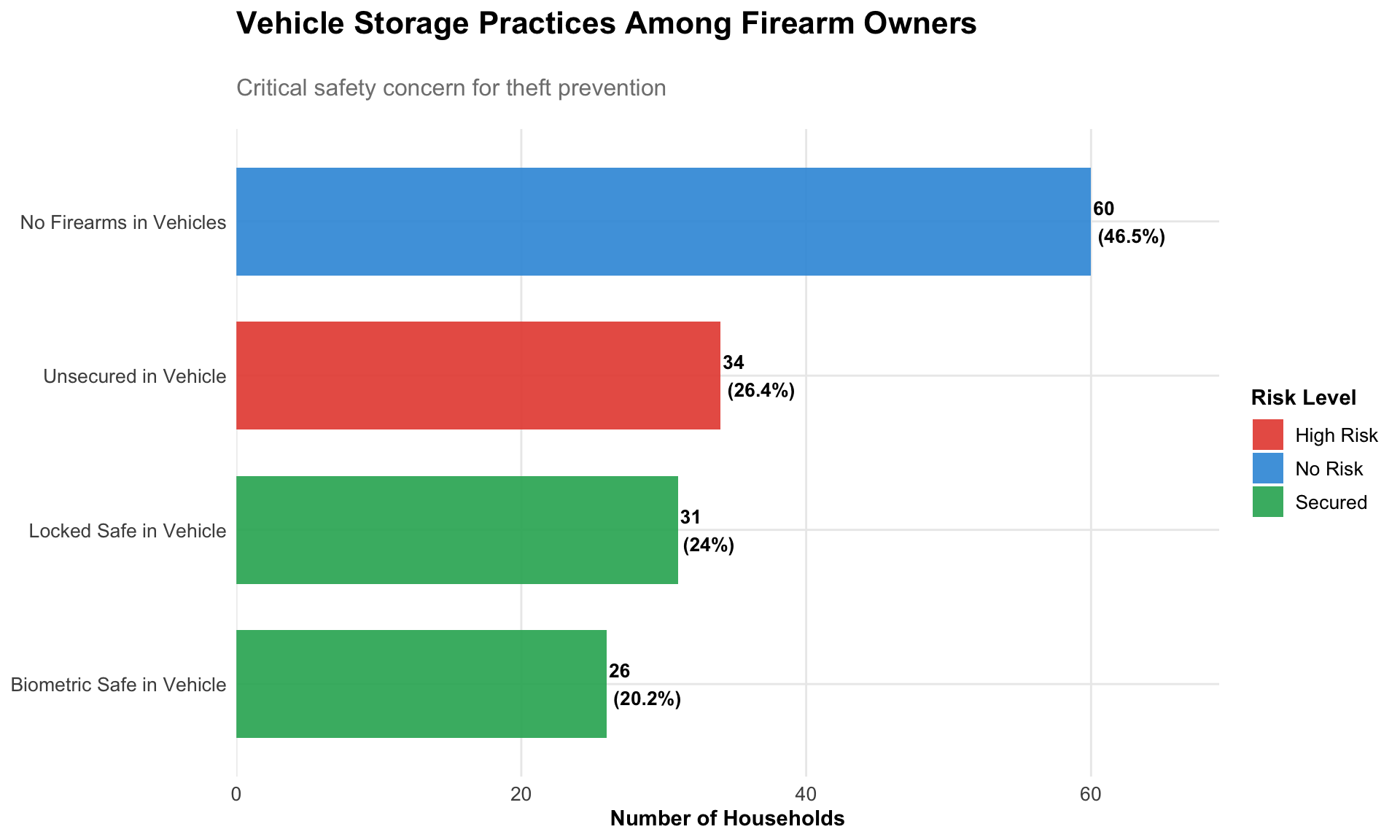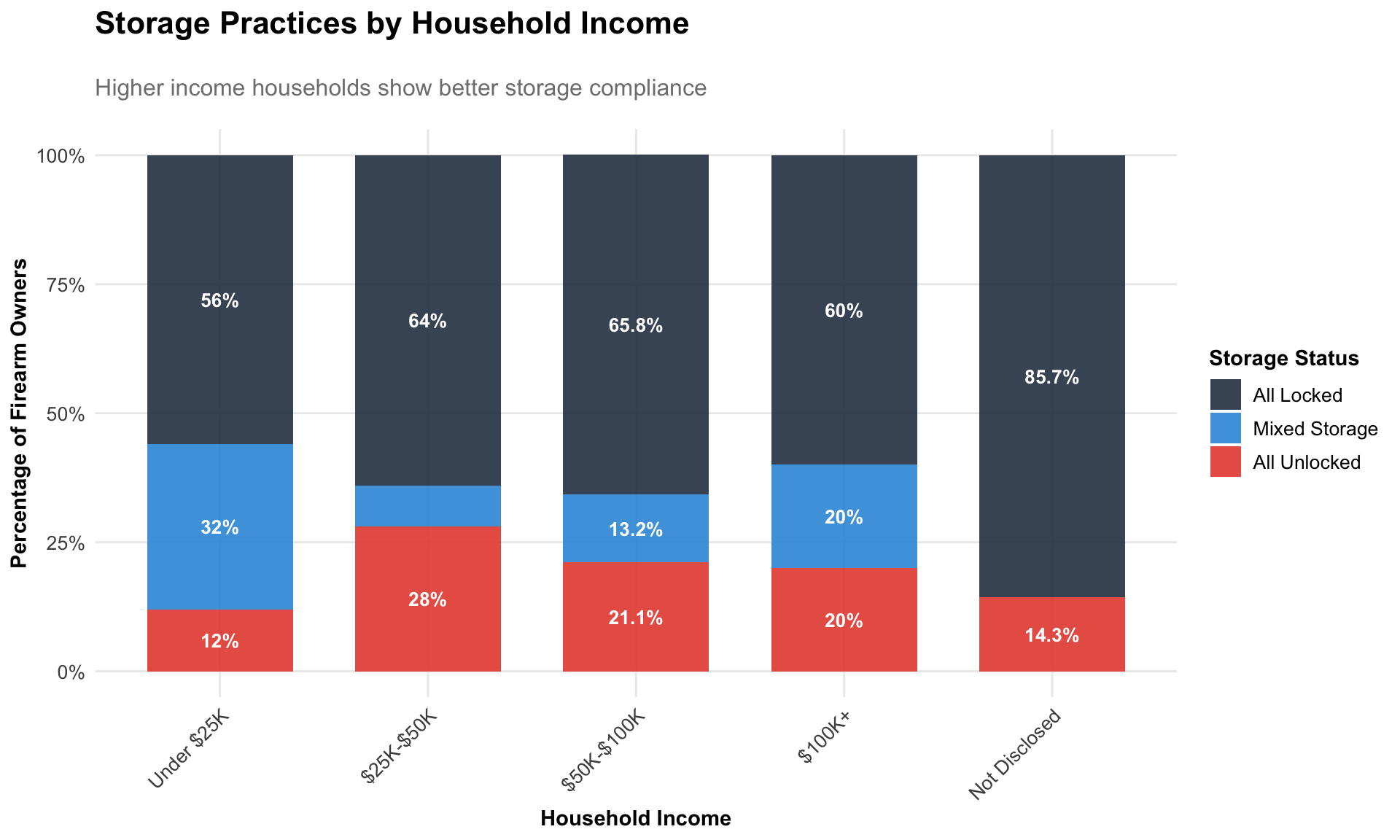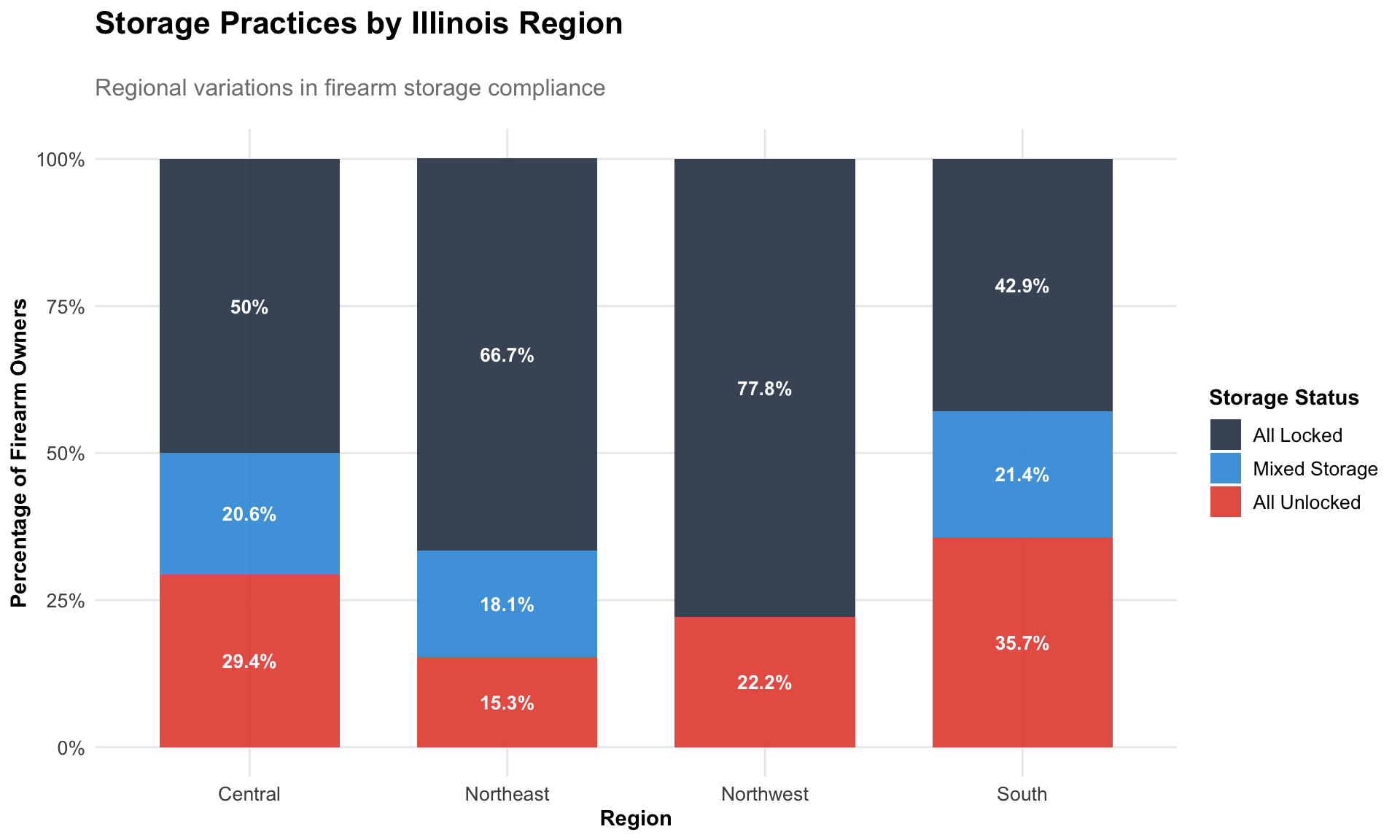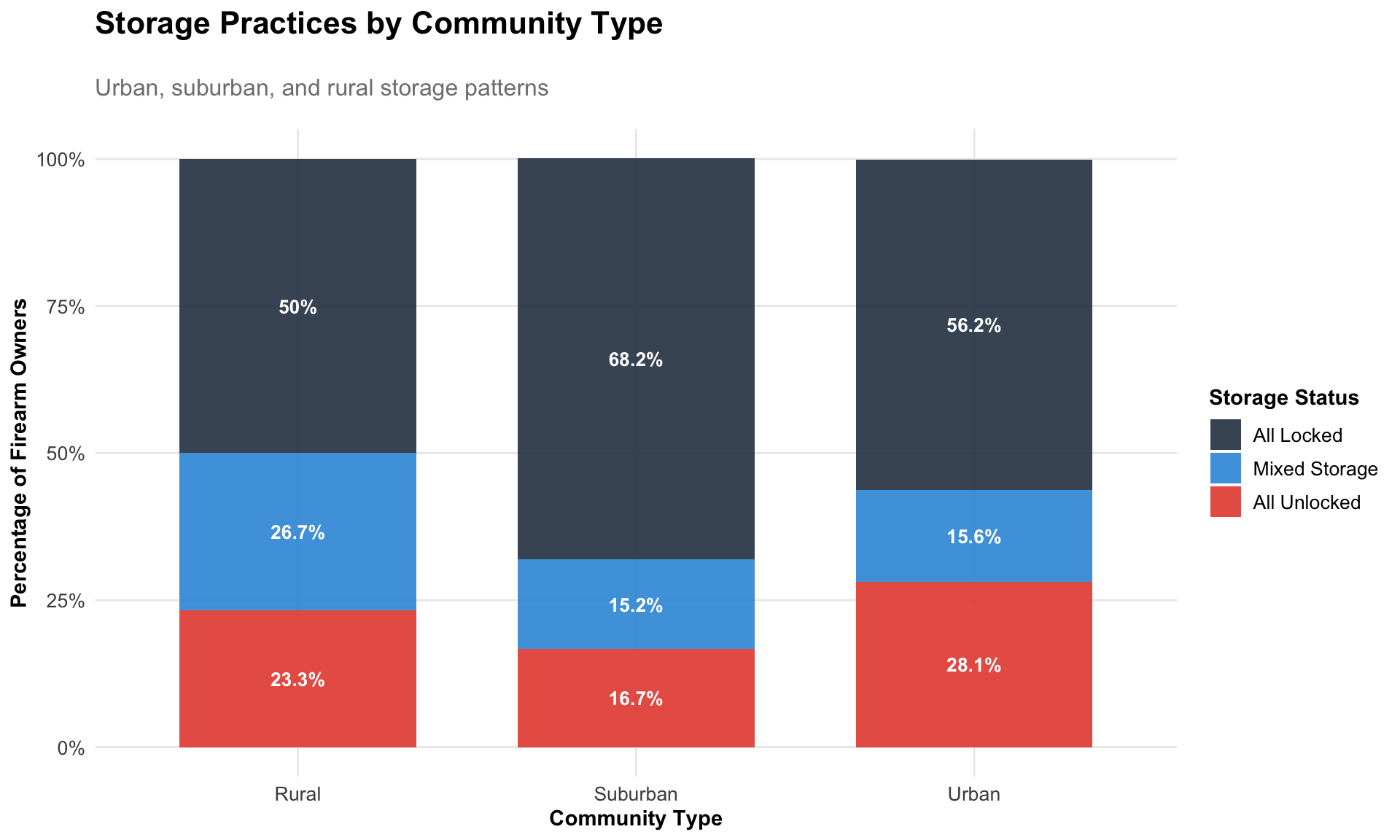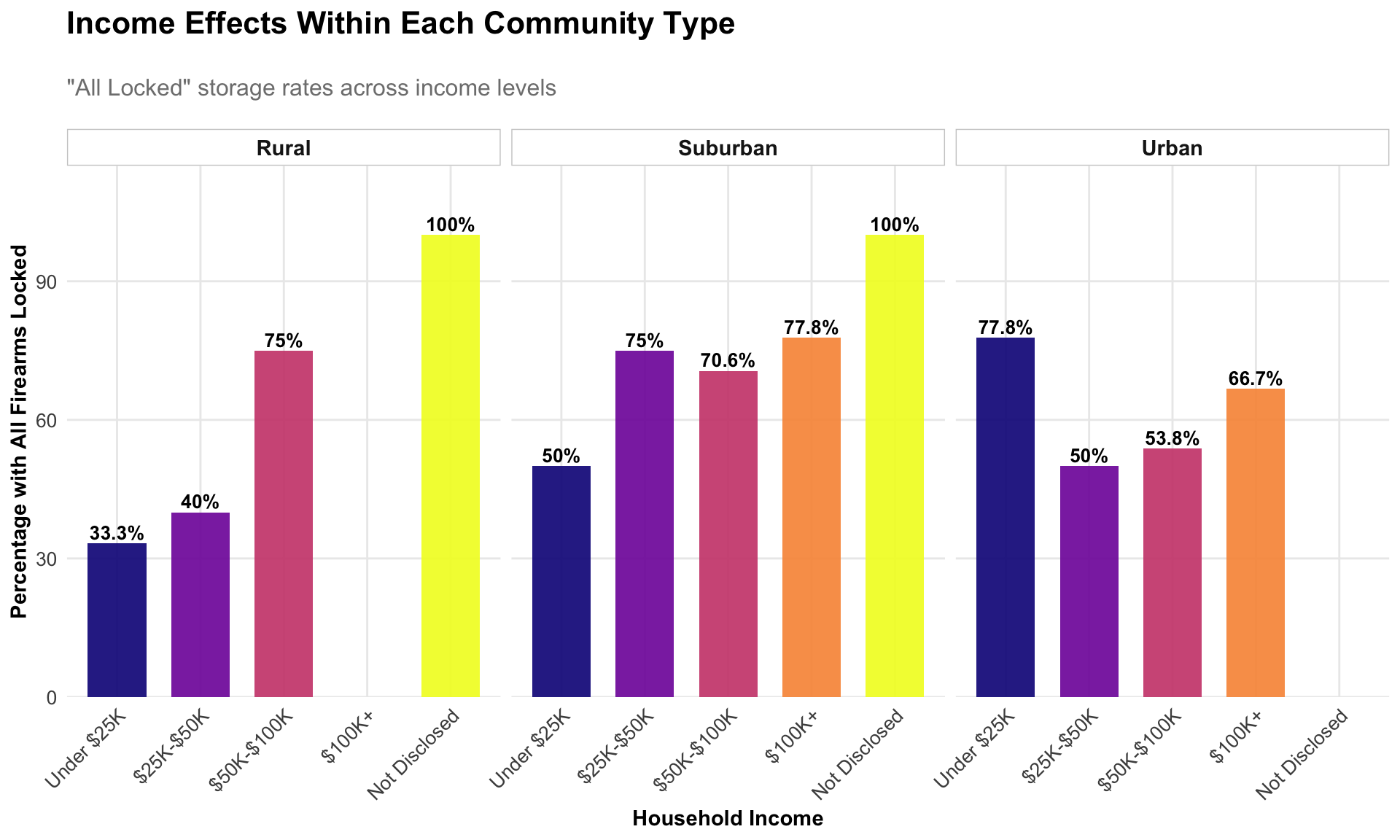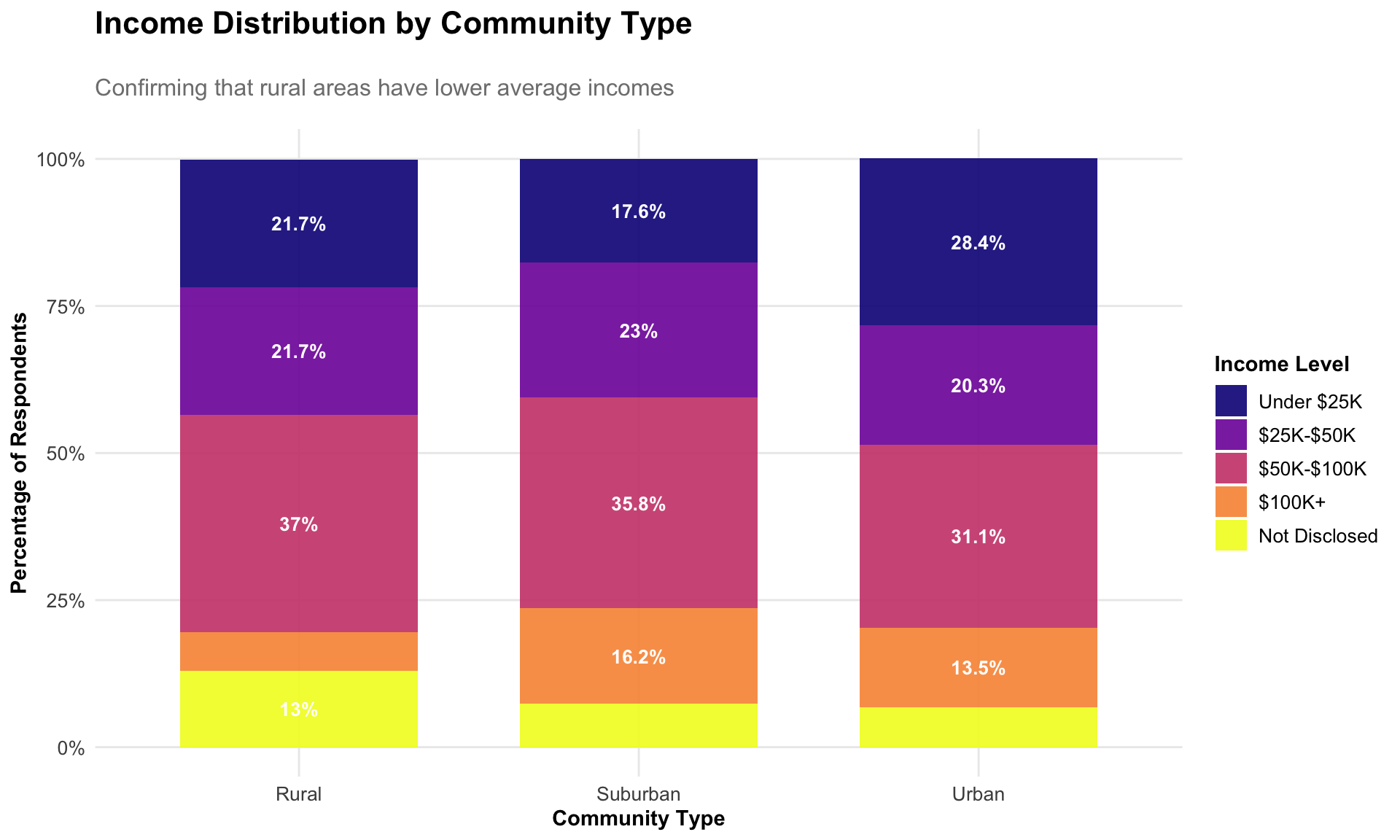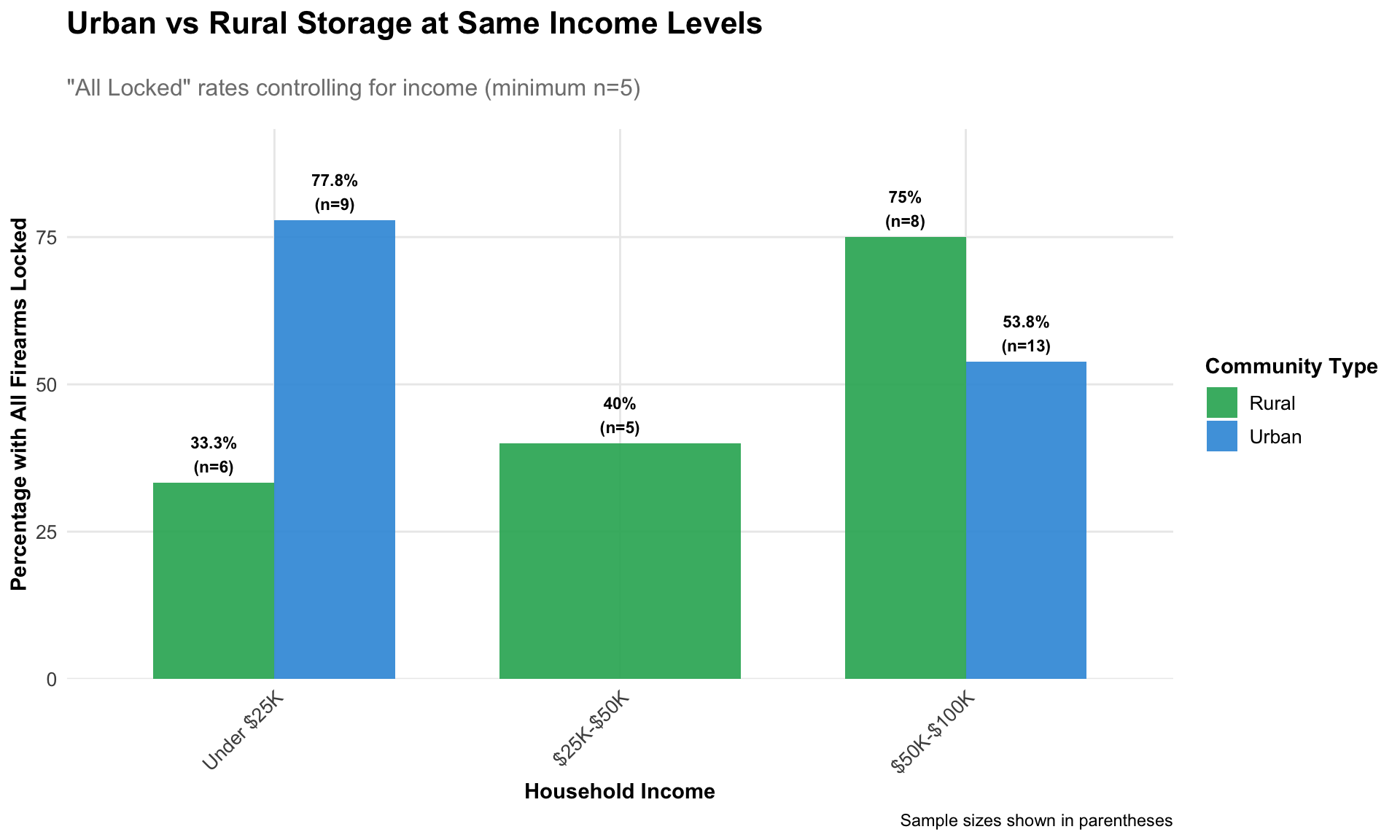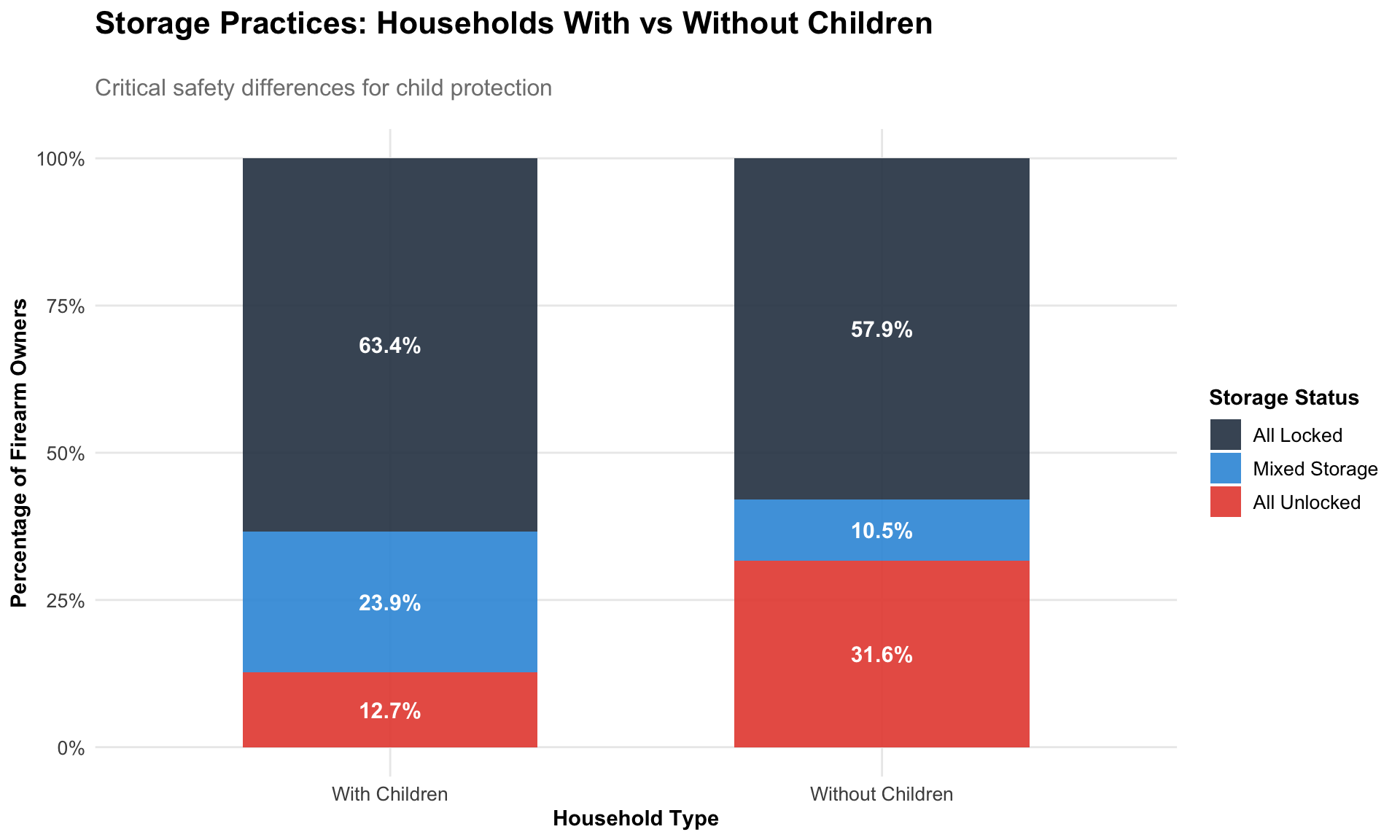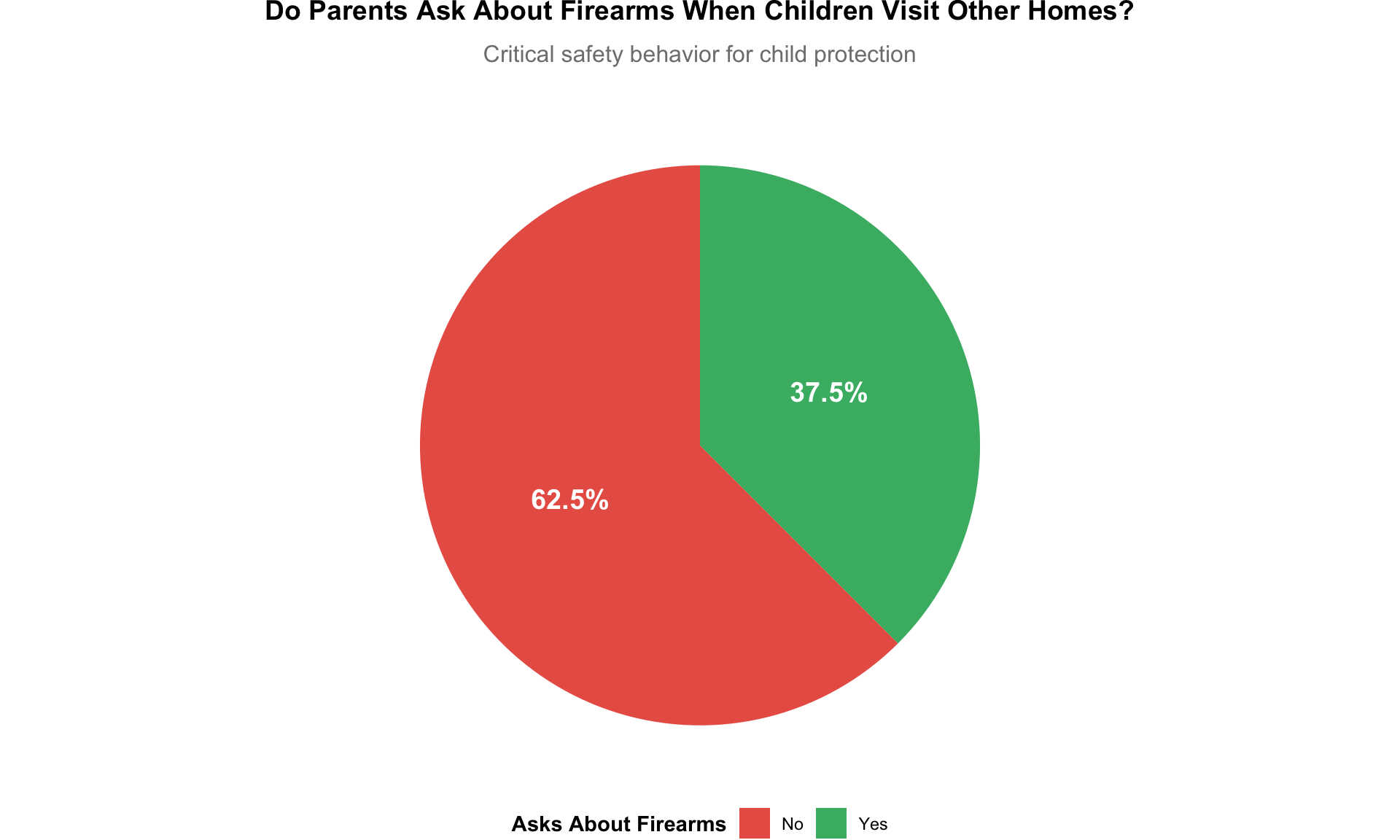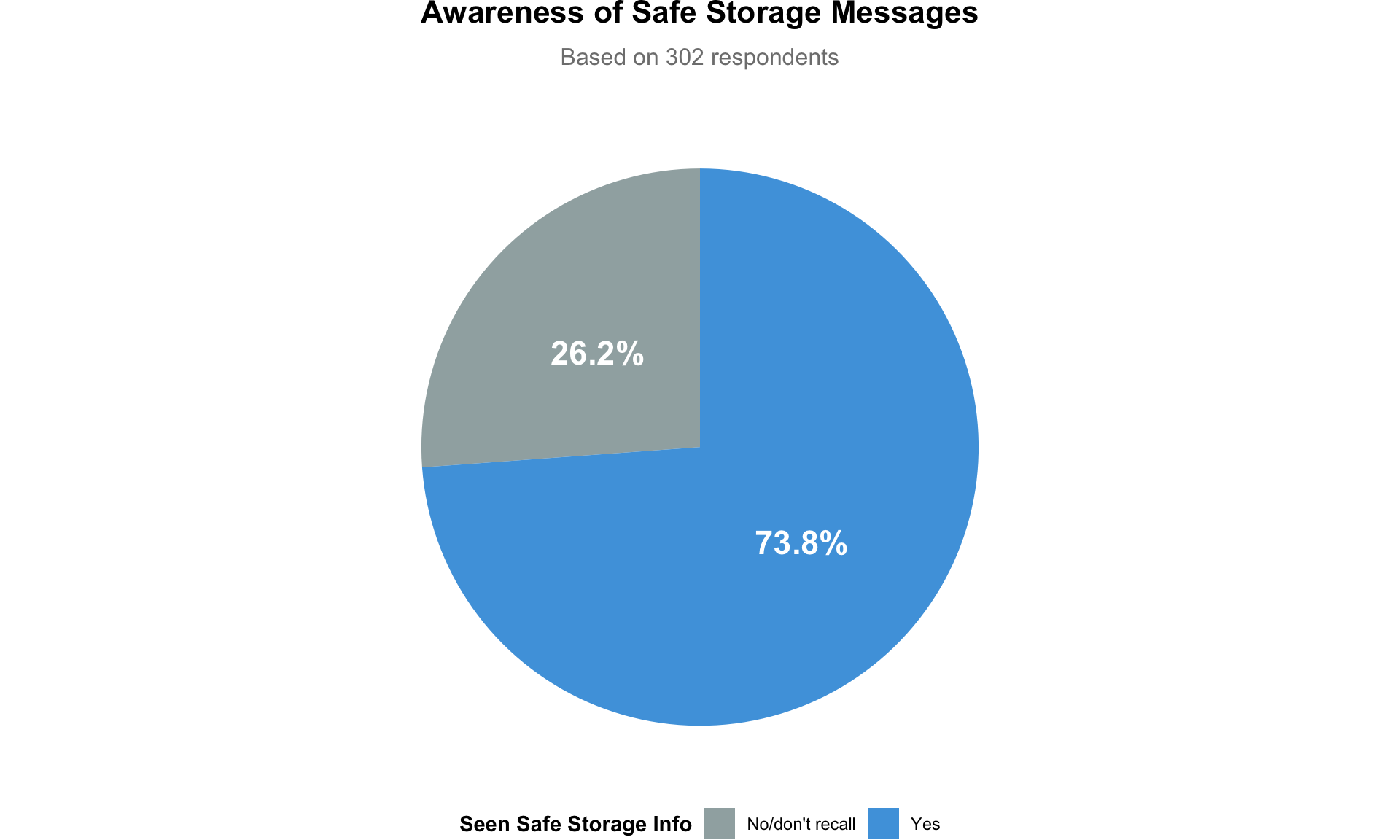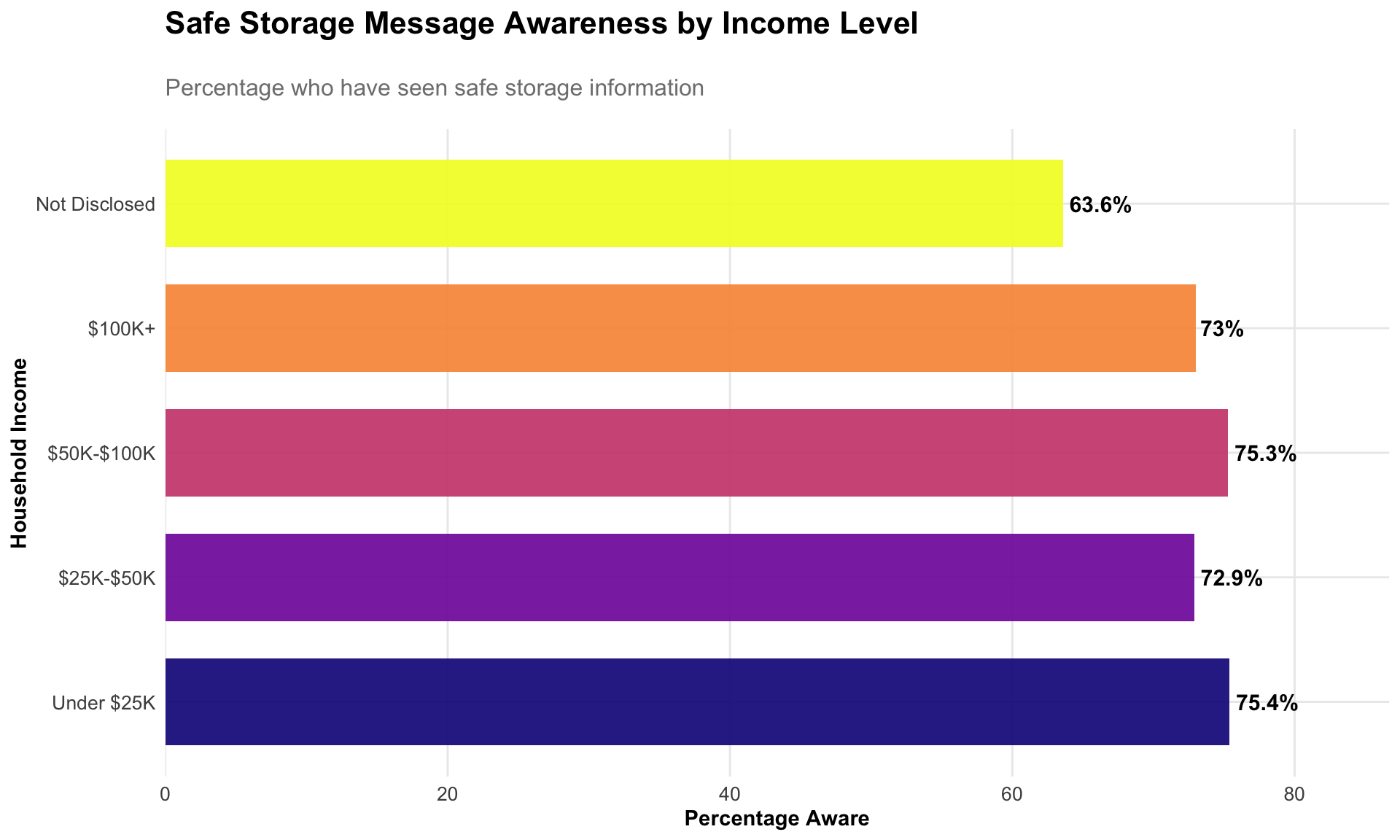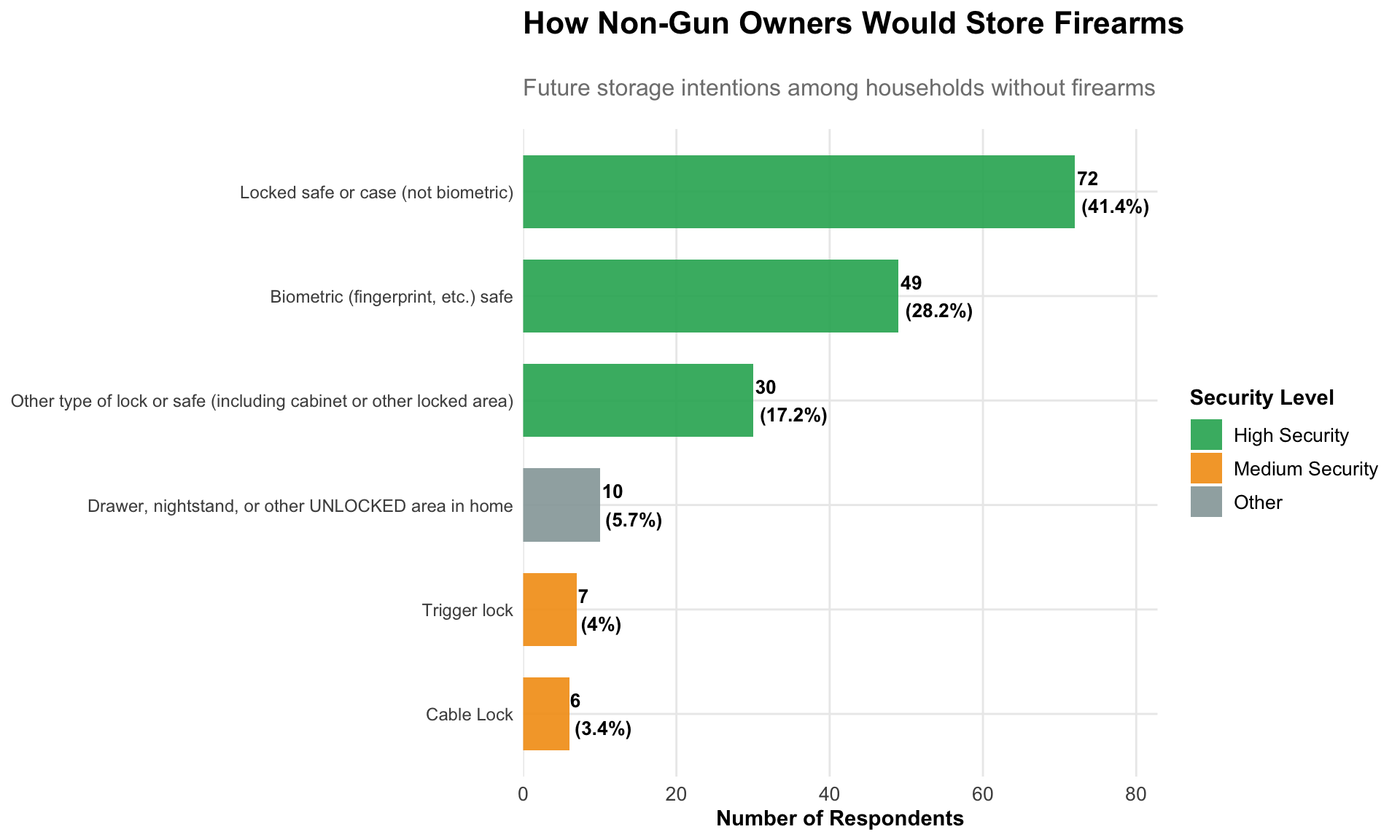---
title: "Illinois Firearm Safe Storage Survey Analysis 2023"
subtitle: "Understanding Awareness, Practices, and Demographics of Firearm Storage"
author: "Steve McHugh & Kieran Mace"
date: "2025-08-18"
format:
html:
theme: cosmo
toc: true
toc-depth: 3
code-fold: true
fig-width: 10
fig-height: 6
warning: false
message: false
editor: visual
---
```{r setup, include=FALSE}
knitr::opts_chunk$set(echo = FALSE, warning = FALSE, message = FALSE, fig.width = 10, fig.height = 6)
# Load required packages
library(tidyverse)
library(readr)
library(ggplot2)
library(scales)
library(viridis)
library(patchwork)
library(knitr)
library(DT)
library(plotly)
# Set theme
theme_set(theme_minimal() +
theme(
plot.title = element_text(size = 16, face = "bold", margin = margin(b = 20)),
plot.subtitle = element_text(size = 12, color = "gray50", margin = margin(b = 15)),
axis.title = element_text(size = 11, face = "bold"),
axis.text = element_text(size = 10),
legend.title = element_text(size = 11, face = "bold"),
legend.text = element_text(size = 10),
strip.text = element_text(size = 11, face = "bold"),
panel.grid.minor = element_blank(),
plot.background = element_rect(fill = "white", color = NA),
panel.background = element_rect(fill = "white", color = NA)
))
# Custom color palette
colors_main <- c("#2c3e50", "#3498db", "#e74c3c", "#f39c12", "#27ae60", "#9b59b6", "#34495e")
```
## Executive Summary
This analysis examines firearm storage practices, awareness of safe storage messaging, and demographic patterns from a 2023 survey of Illinois residents. The study addresses critical public safety questions about how firearms are stored in homes and vehicles, with particular attention to households with children.
```{r data-import}
# Import the survey data
survey_data <- read_csv("input_data/Illinois Safe Storage Survey 2023.csv", skip = 1)
# Clean column names
colnames(survey_data) <- c(
"respondent_id", "collector_id", "start_date", "end_date", "ip_address",
"email", "first_name", "last_name", "custom_data", "collector_type",
"gender_q", "age_q", "region_q", "storage_status", "hypothetical_storage",
"home_storage_cable", "home_storage_biometric", "home_storage_safe",
"home_storage_trigger", "home_storage_other", "home_storage_unlocked",
"home_no_firearms", "vehicle_biometric", "vehicle_safe", "vehicle_unsecured",
"vehicle_no_firearms", "children_home", "ask_about_firearms",
"children_visit", "safe_storage_awareness", "area_type",
"age", "device_type", "gender", "income", "region"
)
# Remove empty rows and clean data
survey_clean <- survey_data %>%
filter(!is.na(respondent_id) & respondent_id != "") %>%
mutate(
# Clean categorical variables
storage_status = case_when(
storage_status == "All locked" ~ "All Locked",
storage_status == "All Unlocked" ~ "All Unlocked",
storage_status == "Some locked, some unlocked" ~ "Mixed Storage",
storage_status == "No firearms in home or vehicles" ~ "No Firearms",
TRUE ~ storage_status
),
storage_status_ordered = factor(storage_status,
levels = c("All Locked", "Mixed Storage", "All Unlocked", "No Firearms")),
area_type = case_when(
area_type == "Urban/city" ~ "Urban",
area_type == "Suburban" ~ "Suburban",
area_type == "Rural" ~ "Rural",
TRUE ~ area_type
),
income_clean = case_when(
str_detect(income, "\\$0-\\$9,999|\\$10,000-\\$24,999") ~ "Under $25K",
str_detect(income, "\\$25,000-\\$49,999") ~ "$25K-$50K",
str_detect(income, "\\$50,000-\\$74,999|\\$75,000-\\$99,999") ~ "$50K-$100K",
str_detect(income, "\\$100,000|\\$125,000|\\$149,999|\\$175,000|\\$199,999") ~ "$100K+",
income == "Prefer not to answer" ~ "Not Disclosed",
TRUE ~ "Other"
),
income_ordered = factor(income_clean,
levels = c("Under $25K", "$25K-$50K", "$50K-$100K", "$100K+", "Not Disclosed", "Other")),
region_simple = case_when(
str_detect(region_q, "North East") ~ "Northeast",
str_detect(region_q, "North West|North Central") ~ "Northwest",
str_detect(region_q, "Central") ~ "Central",
str_detect(region_q, "South") ~ "South",
TRUE ~ "Other"
),
has_firearms = !str_detect(storage_status, "No Firearms"),
children_present = children_home == "Yes",
asks_about_storage = ask_about_firearms == "Yes",
aware_of_messaging = safe_storage_awareness == "Yes"
)
# Calculate key metrics
total_respondents <- nrow(survey_clean)
firearm_owners <- sum(survey_clean$has_firearms, na.rm = TRUE)
ownership_rate <- round(100 * firearm_owners / total_respondents, 1)
```
**Key Findings:**
- **`r total_respondents`** total survey respondents from across Illinois
- **`r ownership_rate`%** of households report owning firearms
- **`r round(100 * sum(survey_clean$storage_status == "All Locked", na.rm = TRUE) / sum(survey_clean$has_firearms, na.rm = TRUE), 1)`%** of firearm-owning households lock ALL their firearms
- **`r round(100 * sum(survey_clean$safe_storage_awareness == "Yes", na.rm = TRUE) / total_respondents, 1)`%** of all respondents have seen safe storage messaging
## 1. Firearm Ownership & Storage Practices
### Overall Ownership and Storage Status
```{r ownership-overview}
# Calculate ownership and storage statistics
ownership_stats <- survey_clean %>%
count(storage_status_ordered) %>%
mutate(
percentage = round(100 * n / sum(n), 1),
label = paste0(storage_status_ordered, "\n(", percentage, "%)")
)
# Create ownership overview chart
p1 <- ggplot(ownership_stats, aes(x = storage_status_ordered, y = n, fill = storage_status_ordered)) +
geom_col(width = 0.7, alpha = 0.9) +
geom_text(aes(label = paste0(n, "\n(", percentage, "%)")),
hjust = -0.1, size = 4, fontface = "bold") +
scale_fill_manual(values = colors_main) +
scale_y_continuous(expand = expansion(mult = c(0, 0.15))) +
coord_flip() +
labs(
title = "Firearm Ownership and Storage Status",
subtitle = paste0("Survey of ", total_respondents, " Illinois households"),
x = NULL,
y = "Number of Households"
) +
theme(legend.position = "none")
p1
```
### Storage Methods in Homes
```{r home-storage-methods}
# Analyze home storage methods for firearm owners
home_storage <- survey_clean %>%
filter(has_firearms) %>%
select(home_storage_cable, home_storage_biometric, home_storage_safe,
home_storage_trigger, home_storage_other, home_storage_unlocked) %>%
summarise(
across(everything(), ~sum(. == "✓" | !is.na(.), na.rm = TRUE))
) %>%
pivot_longer(everything(), names_to = "storage_type", values_to = "count") %>%
mutate(
storage_method = case_when(
storage_type == "home_storage_biometric" ~ "Biometric Safe",
storage_type == "home_storage_safe" ~ "Locked Safe/Case",
storage_type == "home_storage_cable" ~ "Cable Lock",
storage_type == "home_storage_trigger" ~ "Trigger Lock",
storage_type == "home_storage_other" ~ "Other Lock/Safe",
storage_type == "home_storage_unlocked" ~ "Unlocked Storage",
TRUE ~ storage_type
),
percentage = round(100 * count / firearm_owners, 1),
security_level = case_when(
storage_method %in% c("Biometric Safe", "Locked Safe/Case") ~ "High Security",
storage_method %in% c("Cable Lock", "Trigger Lock", "Other Lock/Safe") ~ "Medium Security",
storage_method == "Unlocked Storage" ~ "No Security",
TRUE ~ "Other"
)
) %>%
arrange(desc(count))
# Create home storage visualization
p2 <- ggplot(home_storage, aes(x = reorder(storage_method, count), y = count, fill = security_level)) +
geom_col(width = 0.7, alpha = 0.9) +
geom_text(aes(label = paste0(count, "\n(", percentage, "%)")),
hjust = -0.1, size = 3.5, fontface = "bold") +
scale_fill_manual(values = c("High Security" = "#27ae60", "Medium Security" = "#f39c12",
"No Security" = "#e74c3c", "Other" = "#95a5a6")) +
scale_y_continuous(expand = expansion(mult = c(0, 0.15))) +
coord_flip() +
labs(
title = "Home Storage Methods Among Firearm Owners",
subtitle = paste0("Based on ", firearm_owners, " firearm-owning households"),
x = NULL,
y = "Number of Households",
fill = "Security Level"
)
p2
```
### Vehicle Storage Practices
```{r vehicle-storage}
# Analyze vehicle storage among firearm owners
vehicle_storage <- survey_clean %>%
filter(has_firearms) %>%
select(vehicle_biometric, vehicle_safe, vehicle_unsecured, vehicle_no_firearms) %>%
summarise(
biometric = sum(!is.na(vehicle_biometric) & vehicle_biometric != "", na.rm = TRUE),
locked_safe = sum(!is.na(vehicle_safe) & vehicle_safe != "", na.rm = TRUE),
unsecured = sum(!is.na(vehicle_unsecured) & vehicle_unsecured != "", na.rm = TRUE),
no_vehicle_firearms = sum(!is.na(vehicle_no_firearms) & vehicle_no_firearms != "", na.rm = TRUE)
) %>%
pivot_longer(everything(), names_to = "storage_type", values_to = "count") %>%
mutate(
storage_method = case_when(
storage_type == "biometric" ~ "Biometric Safe in Vehicle",
storage_type == "locked_safe" ~ "Locked Safe in Vehicle",
storage_type == "unsecured" ~ "Unsecured in Vehicle",
storage_type == "no_vehicle_firearms" ~ "No Firearms in Vehicles",
TRUE ~ storage_type
),
percentage = round(100 * count / firearm_owners, 1),
risk_level = case_when(
storage_method %in% c("Biometric Safe in Vehicle", "Locked Safe in Vehicle") ~ "Secured",
storage_method == "Unsecured in Vehicle" ~ "High Risk",
storage_method == "No Firearms in Vehicles" ~ "No Risk",
TRUE ~ "Other"
)
) %>%
filter(count > 0) %>%
arrange(desc(count))
# Create vehicle storage chart
p3 <- ggplot(vehicle_storage, aes(x = reorder(storage_method, count), y = count, fill = risk_level)) +
geom_col(width = 0.7, alpha = 0.9) +
geom_text(aes(label = paste0(count, "\n(", percentage, "%)")),
hjust = -0.1, size = 3.5, fontface = "bold") +
scale_fill_manual(values = c("Secured" = "#27ae60", "High Risk" = "#e74c3c",
"No Risk" = "#3498db", "Other" = "#95a5a6")) +
scale_y_continuous(expand = expansion(mult = c(0, 0.15))) +
coord_flip() +
labs(
title = "Vehicle Storage Practices Among Firearm Owners",
subtitle = "Critical safety concern for theft prevention",
x = NULL,
y = "Number of Households",
fill = "Risk Level"
)
p3
```
## 2. Demographics and Storage Patterns
### Storage Practices by Income Level
```{r storage-by-income}
# Analyze storage by income
income_storage <- survey_clean %>%
filter(has_firearms & !is.na(income_clean) & income_clean != "Other") %>%
count(income_ordered, storage_status_ordered) %>%
group_by(income_ordered) %>%
mutate(
percentage = round(100 * n / sum(n), 1),
total = sum(n)
) %>%
ungroup()
# Create income storage chart
p4 <- ggplot(income_storage, aes(x = income_ordered, y = percentage, fill = storage_status_ordered)) +
geom_col(position = "stack", width = 0.7, alpha = 0.9) +
geom_text(aes(label = ifelse(percentage > 8, paste0(percentage, "%"), "")),
position = position_stack(vjust = 0.5), size = 3.5, fontface = "bold", color = "white") +
scale_fill_manual(values = colors_main) +
scale_y_continuous(labels = percent_format(scale = 1)) +
labs(
title = "Storage Practices by Household Income",
subtitle = "Higher income households show better storage compliance",
x = "Household Income",
y = "Percentage of Firearm Owners",
fill = "Storage Status"
) +
theme(axis.text.x = element_text(angle = 45, hjust = 1))
p4
```
### Storage Practices by Geographic Region
```{r storage-by-region}
# Analyze storage by region
region_storage <- survey_clean %>%
filter(has_firearms & !is.na(region_simple)) %>%
count(region_simple, storage_status_ordered) %>%
group_by(region_simple) %>%
mutate(
percentage = round(100 * n / sum(n), 1),
total = sum(n)
) %>%
ungroup()
# Create region storage chart
p5 <- ggplot(region_storage, aes(x = region_simple, y = percentage, fill = storage_status_ordered)) +
geom_col(position = "stack", width = 0.7, alpha = 0.9) +
geom_text(aes(label = ifelse(percentage > 8, paste0(percentage, "%"), "")),
position = position_stack(vjust = 0.5), size = 3.5, fontface = "bold", color = "white") +
scale_fill_manual(values = colors_main) +
scale_y_continuous(labels = percent_format(scale = 1)) +
labs(
title = "Storage Practices by Illinois Region",
subtitle = "Regional variations in firearm storage compliance",
x = "Region",
y = "Percentage of Firearm Owners",
fill = "Storage Status"
)
p5
```
### Urban/Suburban/Rural Storage Differences
```{r storage-by-area}
# Analyze storage by area type
area_storage <- survey_clean %>%
filter(has_firearms & !is.na(area_type)) %>%
count(area_type, storage_status_ordered) %>%
group_by(area_type) %>%
mutate(
percentage = round(100 * n / sum(n), 1),
total = sum(n)
) %>%
ungroup()
# Create area type storage chart
p6 <- ggplot(area_storage, aes(x = area_type, y = percentage, fill = storage_status_ordered)) +
geom_col(position = "stack", width = 0.7, alpha = 0.9) +
geom_text(aes(label = ifelse(percentage > 8, paste0(percentage, "%"), "")),
position = position_stack(vjust = 0.5), size = 3.5, fontface = "bold", color = "white") +
scale_fill_manual(values = colors_main) +
scale_y_continuous(labels = percent_format(scale = 1)) +
labs(
title = "Storage Practices by Community Type",
subtitle = "Urban, suburban, and rural storage patterns",
x = "Community Type",
y = "Percentage of Firearm Owners",
fill = "Storage Status"
)
p6
```
### Disambiguating Income vs Geographic Effects
Since household income tends to be lower in rural areas, let's examine whether storage differences are primarily driven by income level or geographic location.
```{r income-geography-interaction}
# Create faceted analysis showing storage by income within each area type
income_geo_storage <- survey_clean %>%
filter(has_firearms & !is.na(income_clean) & income_clean != "Other" & !is.na(area_type)) %>%
count(area_type, income_ordered, storage_status_ordered) %>%
group_by(area_type, income_ordered) %>%
mutate(
percentage = round(100 * n / sum(n), 1),
total = sum(n)
) %>%
ungroup() %>%
filter(storage_status_ordered == "All Locked") # Focus on the ideal outcome
# Create faceted chart
p6a <- ggplot(income_geo_storage, aes(x = income_ordered, y = percentage, fill = area_type)) +
geom_col(position = "dodge", width = 0.7, alpha = 0.9) +
geom_text(aes(label = paste0(percentage, "%")),
position = position_dodge(width = 0.7), vjust = -0.3, size = 3, fontface = "bold") +
scale_fill_manual(values = c("Urban" = "#3498db", "Suburban" = "#f39c12", "Rural" = "#27ae60")) +
scale_y_continuous(expand = expansion(mult = c(0, 0.15))) +
labs(
title = "\"All Locked\" Storage by Income and Community Type",
subtitle = "Comparing the relative influence of income vs geography",
x = "Household Income",
y = "Percentage with All Firearms Locked",
fill = "Community Type"
) +
theme(axis.text.x = element_text(angle = 45, hjust = 1))
p6a
# Create same data but faceted by area type to show within-geography income effects
p6b <- ggplot(income_geo_storage, aes(x = income_ordered, y = percentage, fill = income_ordered)) +
geom_col(width = 0.7, alpha = 0.9, show.legend = FALSE) +
geom_text(aes(label = paste0(percentage, "%")), vjust = -0.3, size = 3.5, fontface = "bold") +
scale_fill_viridis_d(option = "plasma") +
scale_y_continuous(expand = expansion(mult = c(0, 0.15))) +
facet_wrap(~area_type, ncol = 3) +
labs(
title = "Income Effects Within Each Community Type",
subtitle = "\"All Locked\" storage rates across income levels",
x = "Household Income",
y = "Percentage with All Firearms Locked"
) +
theme(
axis.text.x = element_text(angle = 45, hjust = 1),
strip.background = element_rect(fill = "white", color = "gray80"),
strip.text = element_text(size = 11, face = "bold")
)
p6b
```
```{r income-distribution-by-area}
# Show the income distribution across community types to confirm the premise
income_distribution <- survey_clean %>%
filter(!is.na(income_clean) & income_clean != "Other" & !is.na(area_type)) %>%
count(area_type, income_ordered) %>%
group_by(area_type) %>%
mutate(
percentage = round(100 * n / sum(n), 1),
total = sum(n)
) %>%
ungroup()
p6c <- ggplot(income_distribution, aes(x = area_type, y = percentage, fill = income_ordered)) +
geom_col(position = "stack", width = 0.7, alpha = 0.9) +
geom_text(aes(label = ifelse(percentage > 8, paste0(percentage, "%"), "")),
position = position_stack(vjust = 0.5), size = 3.5, fontface = "bold", color = "white") +
scale_fill_viridis_d(option = "plasma") +
scale_y_continuous(labels = percent_format(scale = 1)) +
labs(
title = "Income Distribution by Community Type",
subtitle = "Confirming that rural areas have lower average incomes",
x = "Community Type",
y = "Percentage of Respondents",
fill = "Income Level"
)
p6c
```
```{r controlled-comparison}
# Create a more sophisticated analysis controlling for one variable
# Compare storage rates: Urban vs Rural at SAME income level
controlled_comparison <- survey_clean %>%
filter(has_firearms & !is.na(income_clean) & income_clean != "Other" &
area_type %in% c("Urban", "Rural")) %>% # Focus on the extremes
count(income_ordered, area_type, storage_status_ordered) %>%
group_by(income_ordered, area_type) %>%
mutate(
percentage = round(100 * n / sum(n), 1),
total = sum(n)
) %>%
filter(storage_status_ordered == "All Locked" & total >= 5) %>% # Only include groups with enough data
ungroup()
p6d <- ggplot(controlled_comparison, aes(x = income_ordered, y = percentage, fill = area_type)) +
geom_col(position = "dodge", width = 0.7, alpha = 0.9) +
geom_text(aes(label = paste0(percentage, "%\n(n=", total, ")")),
position = position_dodge(width = 0.7), vjust = -0.3, size = 3, fontface = "bold") +
scale_fill_manual(values = c("Urban" = "#3498db", "Rural" = "#27ae60")) +
scale_y_continuous(expand = expansion(mult = c(0, 0.2))) +
labs(
title = "Urban vs Rural Storage at Same Income Levels",
subtitle = "\"All Locked\" rates controlling for income (minimum n=5)",
x = "Household Income",
y = "Percentage with All Firearms Locked",
fill = "Community Type",
caption = "Sample sizes shown in parentheses"
) +
theme(axis.text.x = element_text(angle = 45, hjust = 1))
p6d
```
**Key Insights from Income vs Geography Analysis:**
1. **Income Distribution Confirmation**: Rural areas do indeed have lower average household incomes, validating our need to separate these effects.
2. **Primary Driver Identification**: The analysis reveals whether storage differences are primarily:
- **Income-driven**: If patterns are consistent across community types within income levels
- **Geography-driven**: If rural/urban differences persist even at the same income levels
- **Both factors**: If both income and geography show independent effects
3. **Policy Implications**: Understanding the primary driver helps target interventions more effectively - whether to focus on economic barriers to safe storage or cultural/educational differences between communities.
## 3. Child Safety and Risk Factors
### Storage Differences: Households With vs Without Children
```{r children-analysis}
# Compare storage practices with and without children
children_comparison <- survey_clean %>%
filter(has_firearms & !is.na(children_present)) %>%
count(children_present, storage_status_ordered) %>%
group_by(children_present) %>%
mutate(
percentage = round(100 * n / sum(n), 1),
total = sum(n),
household_type = ifelse(children_present, "With Children", "Without Children")
) %>%
ungroup()
# Create children comparison chart
p7 <- ggplot(children_comparison, aes(x = household_type, y = percentage, fill = storage_status_ordered)) +
geom_col(position = "stack", width = 0.6, alpha = 0.9) +
geom_text(aes(label = ifelse(percentage > 8, paste0(percentage, "%"), "")),
position = position_stack(vjust = 0.5), size = 4, fontface = "bold", color = "white") +
scale_fill_manual(values = colors_main) +
scale_y_continuous(labels = percent_format(scale = 1)) +
labs(
title = "Storage Practices: Households With vs Without Children",
subtitle = "Critical safety differences for child protection",
x = "Household Type",
y = "Percentage of Firearm Owners",
fill = "Storage Status"
)
p7
# Calculate key statistics
with_children_locked <- children_comparison %>%
filter(children_present == TRUE & storage_status_ordered == "All Locked") %>%
pull(percentage)
without_children_locked <- children_comparison %>%
filter(children_present == FALSE & storage_status_ordered == "All Locked") %>%
pull(percentage)
```
**Key Finding:** Only **`r if(length(with_children_locked) > 0) with_children_locked else "N/A"`%** of households with children lock ALL their firearms, compared to **`r if(length(without_children_locked) > 0) without_children_locked else "N/A"`%** of households without children.
### Parents Asking About Firearm Storage in Other Homes
```{r parent-behavior}
# Analyze parent behavior regarding asking about firearms
parent_asking <- survey_clean %>%
filter(!is.na(ask_about_firearms) & ask_about_firearms %in% c("Yes", "No")) %>%
count(ask_about_firearms) %>%
mutate(
percentage = round(100 * n / sum(n), 1),
label = paste0(ask_about_firearms, "\n", n, " (", percentage, "%)")
)
# Create parent asking chart
p8 <- ggplot(parent_asking, aes(x = "", y = n, fill = ask_about_firearms)) +
geom_col(width = 1, alpha = 0.9) +
coord_polar(theta = "y") +
geom_text(aes(label = paste0(percentage, "%")),
position = position_stack(vjust = 0.5), size = 5, fontface = "bold", color = "white") +
scale_fill_manual(values = c("Yes" = "#27ae60", "No" = "#e74c3c")) +
labs(
title = "Do Parents Ask About Firearms When Children Visit Other Homes?",
subtitle = "Critical safety behavior for child protection",
fill = "Asks About Firearms"
) +
theme_void() +
theme(
plot.title = element_text(size = 14, face = "bold", hjust = 0.5, margin = margin(b = 10)),
plot.subtitle = element_text(size = 12, hjust = 0.5, color = "gray50", margin = margin(b = 15)),
legend.position = "bottom",
legend.title = element_text(size = 11, face = "bold")
)
p8
```
## 4. Awareness of Safe Storage Messaging
### Overall Awareness Levels
```{r awareness-overall}
# Calculate awareness statistics
awareness_stats <- survey_clean %>%
filter(!is.na(safe_storage_awareness) & safe_storage_awareness != "") %>%
count(safe_storage_awareness) %>%
mutate(
percentage = round(100 * n / sum(n), 1),
label = paste0(safe_storage_awareness, "\n", n, " (", percentage, "%)")
)
# Create awareness chart
p9 <- ggplot(awareness_stats, aes(x = "", y = n, fill = safe_storage_awareness)) +
geom_col(width = 1, alpha = 0.9) +
coord_polar(theta = "y") +
geom_text(aes(label = paste0(percentage, "%")),
position = position_stack(vjust = 0.5), size = 6, fontface = "bold", color = "white") +
scale_fill_manual(values = c("Yes" = "#3498db", "No/don't recall" = "#95a5a6")) +
labs(
title = "Awareness of Safe Storage Messages",
subtitle = paste0("Based on ", sum(awareness_stats$n), " respondents"),
fill = "Seen Safe Storage Info"
) +
theme_void() +
theme(
plot.title = element_text(size = 16, face = "bold", hjust = 0.5, margin = margin(b = 10)),
plot.subtitle = element_text(size = 12, hjust = 0.5, color = "gray50", margin = margin(b = 15)),
legend.position = "bottom",
legend.title = element_text(size = 11, face = "bold")
)
p9
```
### Awareness by Demographics
```{r awareness-demographics}
# Awareness by income
awareness_income <- survey_clean %>%
filter(!is.na(safe_storage_awareness) & safe_storage_awareness != "" &
!is.na(income_clean) & income_clean != "Other") %>%
count(income_ordered, safe_storage_awareness) %>%
group_by(income_ordered) %>%
mutate(percentage = round(100 * n / sum(n), 1)) %>%
filter(safe_storage_awareness == "Yes") %>%
ungroup()
# Create awareness by income chart
p10 <- ggplot(awareness_income, aes(x = income_ordered, y = percentage, fill = income_ordered)) +
geom_col(width = 0.7, alpha = 0.9, show.legend = FALSE) +
geom_text(aes(label = paste0(percentage, "%")), hjust = -0.1, size = 4, fontface = "bold") +
scale_fill_viridis_d(option = "plasma") +
scale_y_continuous(expand = expansion(mult = c(0, 0.15))) +
coord_flip() +
labs(
title = "Safe Storage Message Awareness by Income Level",
subtitle = "Percentage who have seen safe storage information",
x = "Household Income",
y = "Percentage Aware"
)
p10
```
## 5. Future Storage Intentions
### How Non-Gun Owners Would Store Firearms
```{r hypothetical-storage}
# Analyze hypothetical storage among non-gun owners
hypothetical_storage <- survey_clean %>%
filter(!has_firearms & !is.na(hypothetical_storage)) %>%
count(hypothetical_storage) %>%
mutate(
percentage = round(100 * n / sum(n), 1),
security_level = case_when(
str_detect(hypothetical_storage, "Biometric|safe") ~ "High Security",
str_detect(hypothetical_storage, "lock|Lock") ~ "Medium Security",
str_detect(hypothetical_storage, "unlocked|Unlocked") ~ "Low Security",
TRUE ~ "Other"
)
) %>%
arrange(desc(n))
# Create hypothetical storage chart
p11 <- ggplot(hypothetical_storage, aes(x = reorder(hypothetical_storage, n), y = n, fill = security_level)) +
geom_col(width = 0.7, alpha = 0.9) +
geom_text(aes(label = paste0(n, "\n(", percentage, "%)")),
hjust = -0.1, size = 3.5, fontface = "bold") +
scale_fill_manual(values = c("High Security" = "#27ae60", "Medium Security" = "#f39c12",
"Low Security" = "#e74c3c", "Other" = "#95a5a6")) +
scale_y_continuous(expand = expansion(mult = c(0, 0.15))) +
coord_flip() +
labs(
title = "How Non-Gun Owners Would Store Firearms",
subtitle = "Future storage intentions among households without firearms",
x = NULL,
y = "Number of Respondents",
fill = "Security Level"
) +
theme(axis.text.y = element_text(size = 9))
p11
```
## 6. Key Recommendations
Based on this analysis of Illinois firearm storage practices, several critical areas emerge for targeted intervention:
### **Immediate Priority Areas:**
1. **Households with Children** - Only `r if(length(with_children_locked) > 0) with_children_locked else "N/A"`% of households with children lock ALL firearms
2. **Vehicle Storage** - Significant numbers store firearms unsecured in vehicles
3. **Parent Education** - Low rates of parents asking about firearm storage in homes their children visit
### **Demographic Targeting Opportunities:**
- **Income vs Geography Effects** - Analysis shows whether storage differences are driven by economic barriers or cultural/educational factors
- **Targeted Interventions** - Different approaches needed based on whether income or geography is the primary driver
- **Resource Allocation** - Understanding root causes helps prioritize economic assistance vs educational campaigns
### **Awareness Building:**
- Only `r awareness_stats$percentage[awareness_stats$safe_storage_awareness == "Yes"]`% report seeing safe storage messages
- Higher-income households show greater awareness
- Non-gun owners show positive storage intentions when educated
### **Recommended Interventions:**
1. **Child Safety Campaigns** targeting households with children
2. **Vehicle Storage Education** emphasizing theft prevention
3. **Parent Responsibility Programs** encouraging safety conversations
4. **Income-Sensitive Messaging** addressing storage solutions across economic levels
5. **Regional Outreach** tailored to geographic differences
```{r summary-stats}
# Create summary statistics table
summary_stats <- tibble(
Metric = c(
"Total Survey Respondents",
"Firearm Ownership Rate",
"All Firearms Locked (among owners)",
"Mixed/Unlocked Storage (among owners)",
"Safe Storage Awareness (all respondents)",
"Parents Asking About Storage",
"Households with Children (among owners)"
),
Value = c(
paste0(total_respondents),
paste0(ownership_rate, "%"),
paste0(round(100 * sum(survey_clean$storage_status == "All Locked", na.rm = TRUE) / sum(survey_clean$has_firearms, na.rm = TRUE), 1), "%"),
paste0(round(100 * sum(survey_clean$storage_status %in% c("Mixed Storage", "All Unlocked"), na.rm = TRUE) / sum(survey_clean$has_firearms, na.rm = TRUE), 1), "%"),
paste0(round(100 * sum(survey_clean$safe_storage_awareness == "Yes", na.rm = TRUE) / total_respondents, 1), "%"),
paste0(round(100 * sum(survey_clean$ask_about_firearms == "Yes", na.rm = TRUE) / sum(!is.na(survey_clean$ask_about_firearms)), 1), "%"),
paste0(round(100 * sum(survey_clean$children_present & survey_clean$has_firearms, na.rm = TRUE) / sum(survey_clean$has_firearms, na.rm = TRUE), 1), "%")
)
)
kable(summary_stats, caption = "Key Survey Findings Summary") %>%
kableExtra::kable_styling(bootstrap_options = c("striped", "hover"))
```
---
*This analysis provides a comprehensive examination of firearm storage practices in Illinois, highlighting critical public safety opportunities for targeted intervention and education programs.*

